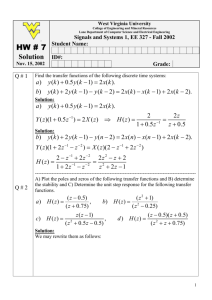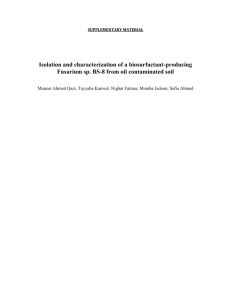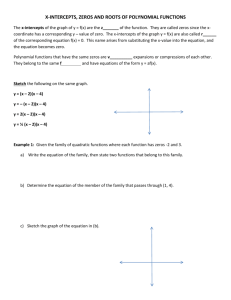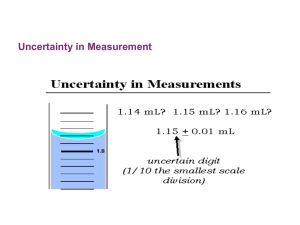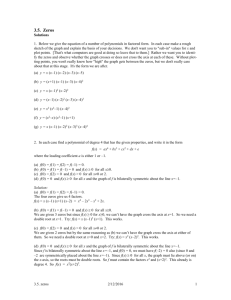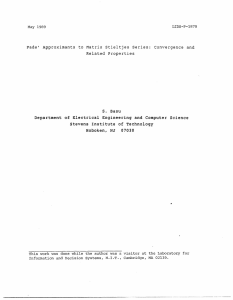FILTERING LONG DURATION SEQUENCES
advertisement
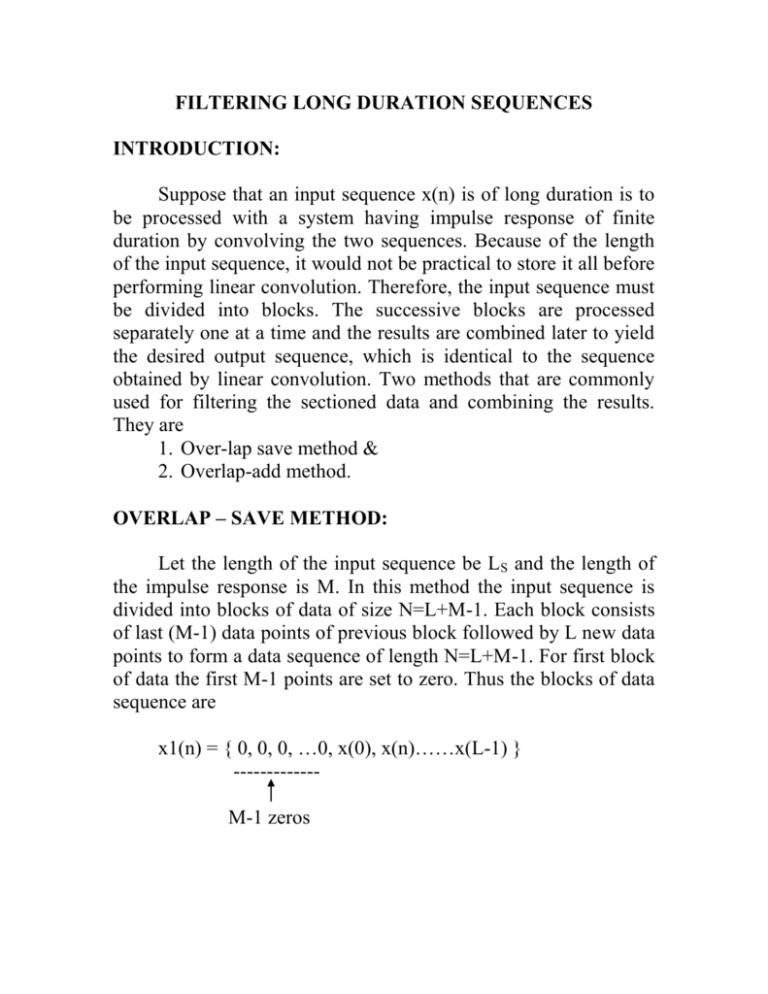
FILTERING LONG DURATION SEQUENCES
INTRODUCTION:
Suppose that an input sequence x(n) is of long duration is to
be processed with a system having impulse response of finite
duration by convolving the two sequences. Because of the length
of the input sequence, it would not be practical to store it all before
performing linear convolution. Therefore, the input sequence must
be divided into blocks. The successive blocks are processed
separately one at a time and the results are combined later to yield
the desired output sequence, which is identical to the sequence
obtained by linear convolution. Two methods that are commonly
used for filtering the sectioned data and combining the results.
They are
1. Over-lap save method &
2. Overlap-add method.
OVERLAP – SAVE METHOD:
Let the length of the input sequence be LS and the length of
the impulse response is M. In this method the input sequence is
divided into blocks of data of size N=L+M-1. Each block consists
of last (M-1) data points of previous block followed by L new data
points to form a data sequence of length N=L+M-1. For first block
of data the first M-1 points are set to zero. Thus the blocks of data
sequence are
x1(n) = { 0, 0, 0, …0, x(0), x(n)……x(L-1) }
------------M-1 zeros
x2(n) = { x(L-M+1), ….x(L-1),
-----------------------M-1 data points from x1(n)
x(L)…….x(2L-1) }
-------------------L new data points
x3(n) = { x(2L-M+1), ….x(2L-1), x(2L) ….x(3L-1) }
and so on.
Now the impulse response of the FIR filter is increased in
length by appending L-1 zeros and an N-point circular convolution
of xi(n) and h(n) is computed.
i.e. yi(n) = xi(n)
N
h(n)
In yi(n), the first (M-1) points will not agree with the linear
convolution of xi(n) and h(n) because of alaising, while the
remaining points are identical to the linear convolution. Hence we
discard the first M-1 points of the filtered section xi(n) N h(n).
The remaining points from successive sections are then abutted to
construct the final filtered output.
For example, let the total length of the sequence LS = 15 and
the length of the impulse response is 3. Let the length of each
block is 5.
Now the input sequence can be divided into blocks as
x1(n) = { 0, 0, x(0), x(1), x(2) }
----M-1 = 2 zeros
x2(n) = { x(1), x(2), x(3), x(4), x(5) }
-----------Last two data points from previous block
-----------x3(n) = { x(4), x(5), x(6), x(7), x(8) }
x4(n) = { x(7), x(8), x(9), x(10), x(11) }
x5(n) = { x(10), x(11), x(12), x(13), x(14) }
x6(n) = { x(13), x(14), 0, 0, 0 }
Now we perform 5 point circular convolution of xi(n) and
h(n) by appending two zeros to the sequence h(n). In the output
block yi(n), first M-1 points are corrupted and must be discarded.
y1(n) = x1(n) N
h(n) = { y1(0), y1(1), y1(2), y1(3), y1(4) }
------------discard
y2(n) = x2(n) N
h(n) = { y2(0), y2(1), y2(2), y2(3), y2(4) }
------------discard
y3(n) = x3(n) N
h(n) = { y3(0), y3(1), y3(2), y3(3), y3(4) }
------------discard
y4(n) = x4(n) N
h(n) = { y4(0), y4(1), y4(2), y4(3), y4(4) }
------------discard
y5(n) = x5(n) N
y6(n) = x6(n) N
h(n) = { y5(0), y5(1), y5(2), y5(3), y5(4) }
------------discard
------------h(n) = { y6(0), y6(1), y6(2), y6(3), 0 }
The output blocks are abutted together to get
y(n) = { y1(2), y1(3), y1(4), y2(2), y2(3), y2(4), y3(2), y3(3),
y3(4), y4(2), y4(3), y4(4), y5(2), y5(3), y5(4), y6(2),
y6(3) }
OVERLAP – ADD METHOD:
Let the length of the sequence is LS and the length of impulse
response is M. The sequence is divided into blocks of data size
having length L and M-1 zeros appended to it to make the data size
of L+M-1.
Thus the data blocks may be represented as
x1(n) = { x1(0), x1(1)……x1(L-1), 0, 0, …. }
----------M-1 zeros appended
x2(n) = { x2(0), x2(1)……x2(2L-1), 0, 0, …. }
x3(n) = { x3(0), x3(1)……x1(3L-1), 0, 0, …. }
Now L-1 zeros are added to the impulse response h(n) and Npoint circular convolution is performed. Since each data block is
terminated with M-1 zeros, the last M-1 points from each output
block must be overlapped and added to the first M-1 points of the
succeeding block. Hence this method is called overlap-add method.
Let the output blocks are of the form
y1(n) = { y1(0), y1(1), …. y1(L-1), y1(L), ….y1(N-1) }
y2(n) = { y2(0), y2(1), …. y2(L-1), y2(L), ….y2(N-1) }
y3(n) = { y3(0), y3(1), …. y3(L-1), y3(L), ….y3(N-1) }
The output sequence is
y(n) = { y1(0), y1(1) …. y1(L-1), y2(0) ….y1(N-1) + y2(M-1),
y2(M), … y2(L) + y3(0), y2(L+1) + y3(1) …y3(N-1) }

